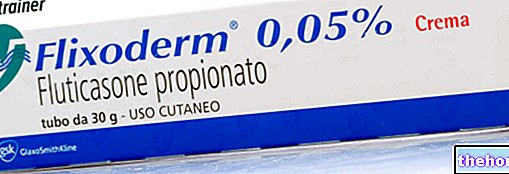Active ingredients: Travoprost
TRAVATAN 40 micrograms / mL eye drops, solution
Indications Why is Travatan used? What is it for?
TRAVATAN contains travoprost, a substance belonging to a group of medicines called prostaglandin analogues. It works by lowering the eye pressure. It can be used alone or in addition to other eye drops such as beta blockers, which can also reduce blood pressure.
TRAVATAN is used to reduce high pressure in the eye in adults, adolescents and children from 2 months of age onwards. This pressure can lead to a condition called glaucoma.
Contraindications When Travatan should not be used
Do not use TRAVATAN if you are allergic to travoprost or any of the other ingredients of this medicine. If so, consult your doctor.
Precautions for use What you need to know before you take Travatan
- TRAVATAN can increase the length, thickness, color and / or number of your lashes. Changes in the eyelids or tissues around the eye including abnormal hair growth have also been observed
- TRAVATAN may change the color of your iris (the colored part of the eye). This change may be permanent. A change in the color of the skin around the eye may also occur.
- If you have had cataract surgery, talk to your doctor before using TRAVATAN
- If you currently have, or have had in the past, eye inflammation (iritis and uveitis), talk to your doctor before using TRAVATAN.
- TRAVATAN may rarely cause breathing difficulties or wheezing or increase asthma symptoms. Tell your doctor immediately if you notice that using TRAVATAN causes changes in your breathing.
- Travoprost can be absorbed through the skin. If any amount of the medicine comes into contact with the skin, it should be washed off immediately. This is especially important in women who are pregnant or planning to conceive
- If you wear soft contact lenses, do not use the drops while wearing the lenses. Wait 15 minutes after using the drops before putting your lenses back in
Children and adolescents
- TRAVATAN can be used in children from 2 months of age to less than 18 years at the same dose as adults. The use of TRAVATAN is not recommended for children under 2 months of age
Interactions Which drugs or foods may change the effect of Travatan
Tell your doctor or pharmacist if you are taking or have recently taken any other medicines
Warnings It is important to know that:
Pregnancy, breastfeeding and fertility
Do not use TRAVATAN if you are pregnant. Talk to your doctor immediately if you think you are pregnant. If you could become pregnant, use effective contraception during treatment.
Do not use TRAVATAN if you are breastfeeding. TRAVATAN can be excreted in milk.
Ask your doctor for advice before taking any medicine.
Driving and using machines
You may have blurred vision for some time after using TRAVATAN. Do not drive or operate machinery until these symptoms disappear.
TRAVATAN contains hydrogenated castor oil and propylene glycol, which can cause skin reactions and irritation.
Dose, Method and Time of Administration How to use Travatan: Posology
Always use this medicine exactly as your doctor or pediatrician has told you. If in doubt, consult your doctor, pediatrician or pharmacist.
The recommended dose is one drop in the eye, once a day - in the evening. Only use TRAVATAN in both eyes as directed by your doctor. Use this medicine for as long as your doctor or pediatrician recommends.
TRAVATAN can only be used as an eye drop.
- Immediately before using the bottle for the first time, open the outer protective wrapping remove the bottle and write the date you opened the bottle in the space provided on the box
- Wash your hands
- Unscrew the cap
- Take the bottle in your hand, between your thumb and other fingers, and hold it pointing downwards
- Tilt your head back or gently pull the baby's head back. Pull the lower lid down with a clean finger to form a "pocket" between the lid and eye. The drop will go there
- Keep the tip of the bottle close to your eye. It may be helpful to use a mirror
- Do not touch your eye or eyelid, surrounding areas or other surfaces with the bottle tip. It may infect the eye drops
- Gently squeeze the bottle to release one drop of TRAVATAN at a time.
- After using TRAVATAN, keep your eyes closed, apply light pressure with your finger to the corner of the eye, near the nose for at least one minute. This helps prevent TRAVATAN from spreading to the rest of the body
- If you use the drops in both eyes, repeat the steps for the other eye
- Tightly close the cap immediately after use
- Use only one bottle at a time. Do not open the protective outer pouch until you are ready to use the bottle.
If a drop misses your eye, try again.
If you or your child are using other ophthalmic preparations such as drops or ointments at the same time, allow at least 5 minutes between instillation of TRAVATAN and instillation of other preparations.
If you forget to use TRAVATAN carry on with the next dose as scheduled. Do not take a double dose to make up for a forgotten dose. Never use more than one drop per day per sick eye.
Do not stop treatment with TRAVATAN without first talking to your doctor or pediatrician, the intraocular pressure will not be controlled and possible loss of vision.
If you have any further questions on the use of this medicine, ask your doctor, pediatrician or pharmacist.
Overdose What to do if you have taken too much Travatan
If you or the child use more TRAVATAN than you should, wash off all of the medicine with warm water. Do not use the drops until it is time for your next dose.
Side Effects What are the side effects of Travatan
Like all medicines, this medicine can cause side effects, although not everybody gets them.
You can generally continue to use the drops, unless the side effects are serious. If you are worried, talk to your doctor or pharmacist. Do not stop taking TRAVATAN without talking to your doctor.
The following side effects have been observed with TRAVATAN.
Very common side effects: may affect more than 1 in 10 users
Effects on the eye: eye redness
Common side effects: may affect up to 1 in 10 users
Effects on the eye: changes in the color of the iris (colored part of the eye), eye pain, eye discomfort, dry eye, itchy eyes, eye irritation
Uncommon side effects: may affect up to 1 in 100 users
Effects on the eye: corneal disease, eye inflammation, iris inflammation, inflammation inside the eye, inflammation of the ocular surface with or without surface damage, sensitivity to light, ocular discharge, inflammation of the eyelids, redness of the eyelids , swelling around the eye, itchy eyelids, reduced vision, blurred vision, increased tearing, infection or inflammation of the conjunctiva (conjunctivitis), abnormal outward rotation of the lower eyelid, clouding of the eye, crusting of the eyelid , eyelash growth, eyelash discolouration, tired eyes.
General side effects: increased allergy symptoms, headache, dizziness, irregular heartbeat, shortness of breath asthma, nasal congestion, throat irritation, darkening of the skin around the eye (s), darkening of the skin, abnormal hair structure , excessive hair growth.
Rare: may affect up to 1 in 1,000 users
Effects on the eye: perception of flashing lights, eyelid eczema, eye swelling, halo vision, decreased eye sensitivity, inflammation of the eyelid glands, pigmentation inside the eye, increased pupil size, change in structure of the eyelashes.
General side effects: viral infection of the eye, unpleasant taste, irregular or decreased heart rate, increased or decreased blood pressure, cough, voice changes, gastrointestinal disorders or ulcer, constipation, dry mouth, red or itchy skin , rash, hair color change, loss of eyelashes, musculoskeletal pain, generalized weakness.
Note: frequency cannot be estimated from the available data.
Effects on the eye: inflammation of the back of the eye, the eyes appear more sunken.
General side effects: depression, anxiety, false sensation of movement, ringing in the ears, chest pain, worsening of asthma, diarrhea, abdominal pain, nausea, itching, abnormal hair growth, joint pain, painful or involuntary urination, increased marker of prostate cancer.
In children and adolescents, the most common side effects seen with TRAVATAN were eye redness and growth of eyelashes. Both side effects were observed with a higher incidence in children and adolescents compared to adults.
Reporting of side effects
If you get any side effects, talk to your doctor or pharmacist. This includes any possible side effects not listed in this leaflet. You can also report side effects directly via the national reporting system. By reporting side effects you can help provide more information on the safety of this medicine.
Expiry and Retention
Keep this medicine out of the sight and reach of children.
Do not use TRAVATAN after the expiry date which is stated on the bottle and carton after "EXP". The expiry date refers to the last day of that month.
This medicinal product does not require any special storage conditions.
To prevent infections, the bottle should be discarded four weeks after first opening and a new bottle should be started. Write the date you opened the bottle in the space on the box.
Do not throw any medicines via wastewater or household waste. Ask your pharmacist how to throw away medicines you no longer use. This will help protect the environment.
Other Information
What TRAVATAN contains
The active substance is travoprost 40 micrograms / ml.
The other ingredients are: Polyquaternium-1, 40 hydrogenated polyhydric castor oil (HCO-40), propylene glycol, sodium chloride, boric acid, mannitol and purified water. Small amounts of hydrochloric acid or sodium hydroxide are added to maintain normal acidity levels (pH levels).
Description of what TRAVATAN looks like and contents of the pack
TRAVATAN is a liquid (a clear, colorless solution) supplied in a pack containing a 4 mL plastic bottle with a screw cap. Each bottle contains 2.5 mL of travoprost eye drops and is placed in a pouch.
Packaging: 1 or 3 bottles.
Not all pack sizes may be marketed.
Source Package Leaflet: AIFA (Italian Medicines Agency). Content published in January 2016. The information present may not be up-to-date.
To have access to the most up-to-date version, it is advisable to access the AIFA (Italian Medicines Agency) website. Disclaimer and useful information.




























